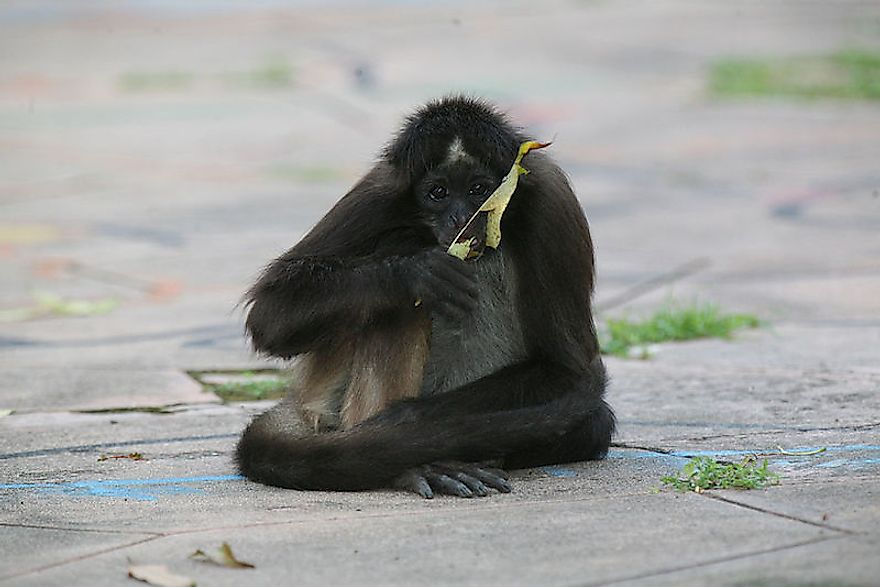Primates Native To Central America

With an increase in human population and encroachment of species habitat, native primates of Central America continue to decline in numbers and are now many are classified as critically endangered animals. Protected national parks have not prevented the illegal hunting of their meat, and this provides another challenge to the continued efforts of preservation. In Central American countries such as Colombia, the black-headed spider monkey has been targeted by poachers. This has threatened its survival to a great extent. Central American countries boast of a rich biodiversity which includes nine of the least documented species of monkey, many of whom are threatened by human activities.
Black-headed Spider Monkey
The Black-headed Spider Monkey, also known as Ateles fusciceps is one of the least documented primates native to Central America. It is known for its long narrow limbs and prehensile (gripping) tail. Black-headed monkeys spend most of their time in trees, where they can jump nine meters from one branch to another. They stay in social groups of about 20 individuals, though they cannot be found all together at the same place. They prefer to travel and feed in smaller sub-groups. The major threat facing the black-headed spider monkey is habitat loss particularly for species in Colombia. They have a life- span of 24 years.
Guatemalan Black Howler
The Guatemalan Black Howler is found in south-eastern Mexico, Belize, northern Guatemala, and possibly northern Honduras. It is one of the largest monkeys in the Americas and is characterized by long, silky, dense coat of black fur with traces of brown on the shoulders, cheek, and back. The arms and legs are stout, and the tail is prehensile. It is found in primary and secondary lowland tropical rainforest and semi-deciduous forest. In the current state, the Guatemalan Black Howler is threatened throughout most of its range from hunting and habitat destruction. The forest habitat of these monkeys has also been rapidly lost and fragmented through conversion to pasture and agricultural lands, and to logging operations.
Geoffroy's Spider Monkey
Also known as the black-handed spider monkey, they can be found throughout Central America in countries such as Mexico, Belize, Costa Rica, El Salvador, Guatemala, Honduras, Nicaragua, and Panama. They live in the higher levels of the forest canopy and found in primary and secondary rainforest, semi-deciduous forest and cloud forest, as well as mangrove swamp forest. Their coat color varies from light buff to reddish-brown or black depending on the subspecies. The Geoffroy Spider Monkey has suffered from habitat destruction through deforestation and conversion of forests to agricultural lands. They are also hunted food and pet trade.
Coiba Island Howler
The Coiba Island Howler is found on Coiba Island off the coast of Panama. It has a prehensile tail without hair on the bottom side for grasping during locomotion and feeding. It consumes new leaves and fruit as part of the diet, including flowers and insects sometimes. Due to ongoing rates of habitat loss, it is estimated that this species will experience a decline of 80% over a period of 3 generations (36 years).
Other Endangered Species
Species such as Central American Squirrel Monkey are considered vulnerable while White-headed Capuchin, Geoffroy's Tamarin, and Mantled Howler have a least concern conservation status. The Panamanian Night Monkey is also one of the native primates of Central America that are under careful watch, though there is data deficiency on its conservation status.
Habitat loss due to human activities such agriculture and logging pose a great danger to the survival of the above species. Alternatively, most Central American governments have not put adequate conservation measures and policies to prevent the hunting for food of this endangered species.
The Native Primates Of Central America
| Rank | Latin Name | Common Name | Family | Conservation Status |
|---|---|---|---|---|
| 1 | Ateles fusciceps | Black-headed spider monkey | Atelidae | Critically Endangered |
| 2 | Alouatta pigra | Guatemalan black howler | Atelidae | Endangered |
| 3 | Ateles geoffroyi | Geoffroy's spider monkey | Atelidae | Endangered |
| 4 | Alouatta coibensis[a] | Coiba Island howler | Atelidae | Vulnerable |
| 5 | Saimiri oerstedii | Central American squirrel monkey | Cebidae | Vulnerable |
| 6 | Cebus capucinus | White-headed capuchin | Cebidae | Least Concern |
| 7 | Saguinus geoffroyi | Geoffroy's tamarin | Callitrichidae | Least Concern |
| 8 | Alouatta palliata | Mantled howler | Atelidae | Least Concern |
| 9 | Aotus zonalis[b] | Panamanian night monkey | Aotidae | Data Deficient |











